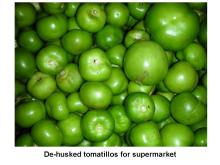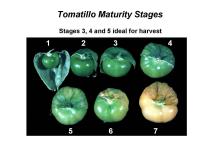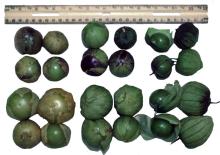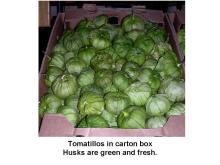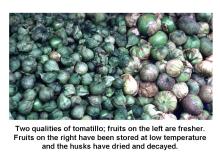Maturity and Quality
The tomatillo or husk tomato (Physalis ixocarpa) is a small, spherical and green or green-purple fruit surrounded by an enlarged calyx or "husk." As the fruit matures, it fills the husk and can split it open by harvest. Tomatillos are the key ingredients in fresh and cooked green salsas and other Latin American dishes. The freshness and greenness of the husk is a quality criteria. Fruit should be firm, bright green as the green color and acidic flavor are the main culinary contributions of tomatillos.
Tomatillos can be harvested at various stages of development. For commercial marketing, they should be harvested when the fruits are well formed and have substantially filled the husk but are still bright green in color. Overmature fruit are light green or yellowing and should be avoided since they are sweeter and undesirable for most uses.
Postharvest Handling and Storage
Tomatillos can be forced-air or room cooled. The main reason to cool rapidly is to retain the fresh appearance of the husk. Tomatillos can be stored under a wide range of conditions. At ambient temperatures, the husks will dry, but the fruit will remain in good condition for about 1 week. For longer storage life temperatures of 5°C to 10°C (41°F to 50°F) with moderate humidity levels (80-90% RH) are recommended to retain the freshness of the fruit and the husk. At 5°C (41°F) chilling injury will occur after about 3 weeks.
| Temperature | 5°C (41°F) | 10°C (50°F) | 20°C (68°F) |
| ml CO2/kg·hr | 6-7 | 7-10 | 15-20 |
To calculate heat production multiply ml CO2/kg·hr by 440 to get Btu/ton/day or by 122 to get kcal/metric ton/day.
Respiration data are for mature fruit. Respiration rates remain relatively constant during storage at 5°C and 10°C; rates decrease during storage at 20°C. Respiration rates of developing fruit are about 25% higher than those of mature fruit.
Exposure of mature fruit to ethylene causes undesirable color change.
80-90%
Tomatillos produce low amounts of ethylene at immature (0.5 to 2 µl/kg·hr at 10 to 20°C [50 to 68°F]) and mature stages (1 to 10 µl/kg·hr ). At horticulturally overmature stages, i.e. when the fruit show yellow color change due to ripening, ethylene production rates can be high (20-40 µl/kg·hr at 20°C (68°F)).
No information is available.
Disorders
Chilling injury. Tomatillos can be stored at 10°C (50°F) for 1 month without any symptoms of chilling injury. After 3 weeks at 5°C (41°F), the fruit began to show chilling symptoms, and at 2.5°C (36°F), fruit showed significant amounts of chill-induced decay. Typical chilling symptoms include surface pitting and decay.
Chilling injury can result in the appearance of black mold on the fruit due to Alternaria alternata, the same organism found on chill injured tomatoes and peppers. Superficial molds occur on the husk during storage under high humidity conditions, but have not been identified. Washing in chlorinated water reduces superficial mold growth, but may be difficult to implement commercially since it is difficult to remove all moisture from inside the husk.




